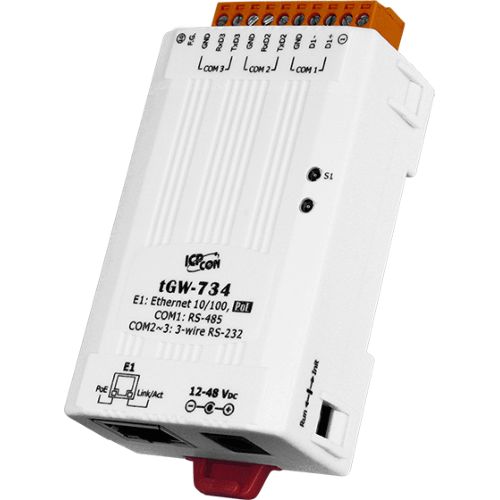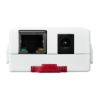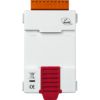features and benefits
Modbus has become a standard industrial communication protocol, and is now the most commonly available means of connecting industrial electronic devices.
Modbus allows for communication between many devices connected to the same RS-485 network, for example, a system that measures temperature and humidity and communicates the results to a computer.
Modbus is often used to connect a supervisory computer with a remote terminal unit (RTU) in supervisory control and data acquisition (SCADA) systems. The tGW-700 is a Modbus TCP to RTU/ASCII gateway that enables a Modbus/TCP host to communicate with serial Modbus RTU/ASCII devices through an Ethernet network, and eliminates the cable length limitation of legacy serial communication devices.
The module can be used to create a pair-connection application (as well as serial-bridge or serial-tunnel application), and can then route data over TCP/IP between two serial Modbus RTU/ASCII devices, which is useful when connecting mainframe computers, servers or other serial devices that use Modbus RTU/ASCII protocols and do not themselves have Ethernet capability. The read-cache function is used to store previous requests and responses in the memory buffer of the tGW-700 module.
When other HMI/SCADA master controllers send the same requests to the same RTU slave device, the cached response is returned immediately.
This feature dramatically reduces the loading on the RS-485 bus communication, ensures faster TCP responses, and improves the stability of the entire system. The tGW-700(Non-T) module offers true IEEE 802.3af-compliant (classification, Class 1) Power over Ethernet (PoE) functionality using a standard category 5 Ethernet cable to receive power from a PoE switch such as the NS-205PSE.
If there is no PoE switch on site, the module will also accept power input from a DC adapter.
The tGW-700 module is designed for ultra-low power consumption, reducing hidden costs from increasing fuel and electricity prices, especially when you have a large number of modules installed.
Reducing the amount of electricity consumed by choosing energy-efficient equipment can have a positive impact on maintaining a green environment.
- Supports Modbus TCP/UDP master and slave
- Supports Modbus RTU/ASCII master and slave
- Max. TCP connections (masters) per serial port: 32
- Read-cache ensures faster Modbus TCP/UDP response
- Supports UDP responder for device discovery (UDP Search)
- Static IP or DHCP network configuration
- Tiny Web server for configuration (HTTP)
- Allows automatic RS-485 direction control
- Terminal block connector for easy wiring
- Cost-effective Modbus gateway
specifications
Ethernet| Ports | 10/100 Base-TX, 8-pin RJ-45 x 1, (Auto-negotiating, Auto-MDI/MDIX, LED indicator) | PoE (IEEE 802.3af, Class 1) |
|---|
COM Ports| Ports | 1 x RS-485 | 2 x 3-wire RS-232 |
|---|
| Baud Rate | 115200 bps Max. |
|---|
| Bias Resistor | Yes, 1 KΩ |
|---|
| Parity | None, Odd, Even, Mark, Space |
|---|
| Data Bit | 5, 6, 7, 8 |
|---|
| Stop Bit | 1, 2 |
|---|
| Node Address | 254 (max.) |
|---|
Power| Consumption | 0.07 A @ 24 VDC |
|---|
| Powered from PoE | IEEE 802.3af, Class 1 |
|---|
| Powered from Terminal Block | +12 ~ 48 VDC |
|---|
Mechanical| Casing | Plastic |
|---|
| Dimensions (mm) | 52 mm x 95 mm x 27 mm (W x H x D) |
|---|
| Installation | DIN-Rail Mounting |
|---|
Environment| Operating Temperature | -25 ~ +75 °C |
|---|
| Storage Temperature | -30 ~ +80 °C |
|---|
| Humidity | 10 ~ 90% RH, non-condensing |
|---|







